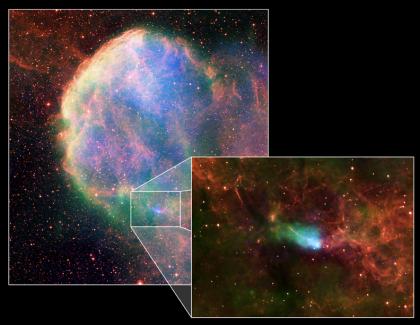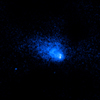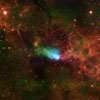The Case of the Neutron Star With a Wayward Wake

Credit: Chandra X-ray: NASA/CXC/B.Gaensler et al; ROSAT X-ray: NASA/ROSAT/Asaoka & Aschenbach; Radio Wide: NRC/DRAO/D.Leahy; Radio Detail: NRAO/VLA; Optical: DSS
This wide-field composite image was made with X-ray (blue/ROSAT & Chandra), radio (green/Very Large Array), and optical (red/Digitized Sky Survey) observations of the supernova remnant, IC 443. The pullout, also a composite with a Chandra X-ray close-up, shows a neutron star that is spewing out a comet-like wake of high-energy particles as it races through space.
Based on an analysis of the swept-back shape of the wake, astronomers deduced that the neutron star known as CXOU J061705.3+222127, or J0617 for short, is moving through the multimillion degree Celsius gas in the remnant. However, this conclusion poses a mystery.
Although there are other examples where neutron stars have been located far away from the center of the supernova remnant, these neutron stars appear to be moving radially away from the center of the remnant. In contrast, the wake of J0617 seems to indicate it is moving almost perpendicularly to that direction.
One possible explanation is that the doomed progenitor star was moving at a high speed before it exploded, so that the explosion site was not at the observed center of the supernova remnant. Fast-moving gusts of gas inside the supernova remnant may have further pushed the pulsar's wake out of alignment. An analogous situation is observed for comets, where a wind of particles from the Sun pushes the comet tail away from the Sun, out of alignment with the comet's motion.
If this is what is happening, then observations of the neutron star with Chandra in the next 10 years should show a detectable motion away from the center of the supernova remnant.
|
||||||||||||||||||||||||||||||
An X-ray image of supernova remnant IC443 is shown, featuring a large blue and green nebula in the center of it. The nebula is surrounded by stars and has an irregular circular shape all situated on a dark red and black textured background. Neutron star J0617 is located at the center of the nebula. Neutron stars are incredibly dense celestial objects that form from the remnants of supernova explosions. They are among the most compact objects in the universe, with diameters of only about 10 miles (16 kilometers) and masses several times greater than that of Earth's sun. In this image, neutron star J0617 is pulled out to show a closer view and serves as the focal point of the image. It resembles a little blue-green fish swimming in a sea of red and green algae and seaweed. The nebula surrounding Neutron star J0617 is made up of gas and dust, which glows brightly in X-rays due to its interaction with the high-energy radiation emitted by the neutron star. The wide-field composite image was made with X-ray data (cyan, from ROSAT & Chandra), radio data (green from the Very Large Array), and optical data (red, from the Digitized Sky Survey) observations of the supernova remnant IC 443. The pullout shows the Chandra X-ray Observatory close-up with the radio and optical data, and depicts the neutron star that is spewing out a comet-like wake of high-energy particles as it races through space.





